

Channel Islands Live Bald Eagle Webcams - Channel Islands National Park. Think Tank Orangutan Cam. San Diego Zoo Ape Cam. Holly's Half Dozen - Service Puppy Live Cam - Dog Bless You. Brooks Falls - Brown Bear & Salmon Cam - Bears. This website would like to remind you: Your browser (Firefox 17) is out of date.

Update your browser for more security, comfort and the best experience on this site. Vancouver Aquarium. BigCatHospital on USTREAM: . Wild Animals. Watch without ads Ustream © Search Log in / Sign up With Facebook (faster)
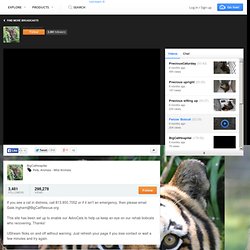
Watch Clouded Leopard Cubs' Mom on the Web Cam. Clouded leopards are bred at the Zoo's Front Royal, Virginia.

They are part of an international program to conserve the species, which is threatened by deforestation and hunting. Clouded Leopards Need You! National Zoo scientists and their colleagues around the world are aggressively working to save this species from decline. One of their goals is to create a genetically diverse population, and the birth of numerous cubs in the past years is a major cause for celebration. In fact, the Zoo's Virginia facility holds the largest population of clouded leopards in North America. We're delighted to present cams, courtesy of CGH Technologies Inc., so people can watch and learn about these beautiful cats. More Clouded Leopard Cub camsClouded Leopard Cub 6. Abandoned Fur Seal Nafanya. Siku Cam. International Wolf Center Learn - Wolf Watch Cam. Welcome to the National Zoo. Monterey Bay Aquarium. Welcome to whalesong.net. Invertebrates at the National Zoo. Great Cats. The Great Cats exhibit on Lion/Tiger Hill features Sumatran tigers and African lions—living, breathing, roaring great cats.
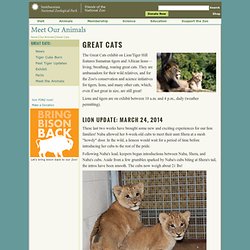
Great Apes and Other Primates. Keepers provide the primates with enrichment—enclosures, socialization, objects, sounds, smells and other stimuli—to enhance their well-being and give them an outlet to demonstrate their species-typical behaviors.
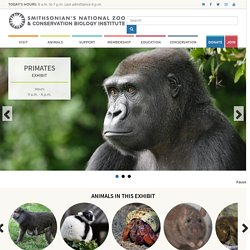
In addition to the Orangutan Rope-Pull and Wet Zone exhibits at Think Tank, animals have plenty of activities to keep them busy throughout the day. The Zoo’s primates receive between four and eight forms of enrichment every day to keep them physically and mentally active. Keepers maintain a detailed calendar to ensure that the items and experiences remain novel and interesting. Giant Pandas.
Sign up to get panda news from the Zoo.
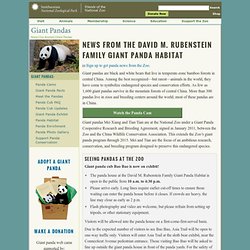
Giant pandas are black and white bears that live in temperate-zone bamboo forests in central China. Among the best recognized—but rarest—animals in the world, they have come to symbolize endangered species and conservation efforts. As few as 1,600 giant pandas survive in the mountain forests of central China. More than 300 pandas live in zoos and breeding centers around the world; most of these pandas are in China. Birds. NestCams Website - View Live Nest Cams, explore photos, video, and daily archives, and view HD footage of nesting behaviors from Macaulay Library. Asia Trail. Amazonia. Frogs and Amphibians In 1999, Smithsonian’s National Zoo and Conservation Biology Institute (SCBI) scientists worked with a researcher at the University of Maine to describe a chytrid fungus that causes the deadly amphibian skin disease chytridiomycosis.
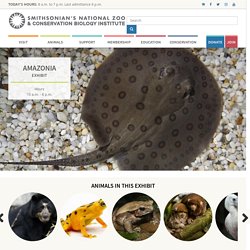
Since then, the understanding of amphibian decline and this disease has improved greatly. Scientists now suspect that amphibian chytrid fungus originated in southern Africa. Chytrid threatens amphibians in the biodiverse hotspots of Central and South America, with more than 25 to 30 species at risk. African Savanna. Cheetah Conservation Station keepers provide the animals with enrichment—enclosures, socialization, objects, sounds, smells and other stimuli—to enhance their well-being and give them an outlet to demonstrate their species-typical behaviors.

An exhibit’s design is carefully and deliberately planned to provide physically and mentally stimulating toys, activities, and environments for the Zoo’s animals. Each enrichment is tailored to give an animal the opportunity to use its natural behaviors in novel and exciting ways. As with any enrichment activity, an animal can either choose to participate or not. To encourage the animals to forage as they would in the wild, keepers scatter food throughout the exhibit or place it in various puzzle feeders in the yards. They receive numerous feedings in various locations to keep them moving throughout the day. A Live 24x7 Interactive African Wildlife Safari. Live Cameras - Hancock Wildlife Foundation. Eagle Camera. Welcome to the online home of Carolina Raptor Center’s Bald Eagle nesting pair – Savannah and Derek Eagle!
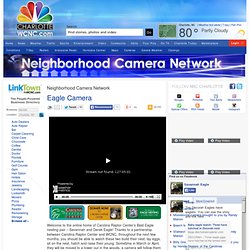
Thanks to a partnership between Carolina Raptor Center and WCNC, throughout the next few months, you should be able to watch these two build their nest, lay eggs, sit on the nest, hatch and raise their young. Sometime in March or April, they will be moved to a tower out in the woods, a camera will follow them there for the last few weeks but understand that the picture there won’t be as good because of the lack of power out there. To visit the Carolina Raptor Center website, click here. If you would like to donate to support the work of Carolina Raptor Center, click here.
For a history of Eagle Nesting at Carolina Raptor Center, please click here. Carolina Raptor Center is dedicated to environmental stewardship and the conservation of birds of prey through education, research, and the rehabilitation of injured and orphaned raptors. Siku Cam - Polar Bears. Whale watching tv - Whale Watching. Viewing Area Webcam - Live Video.